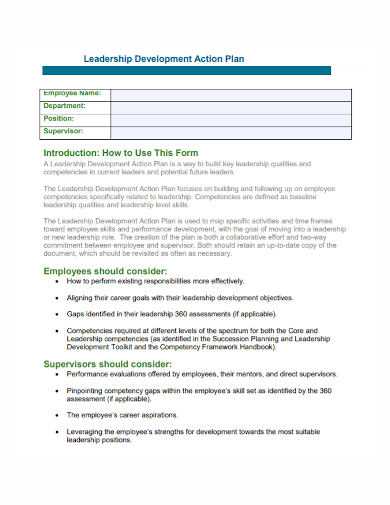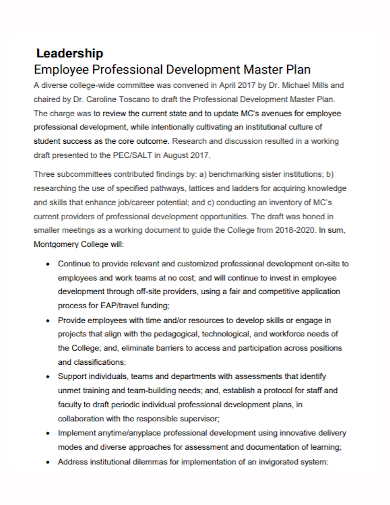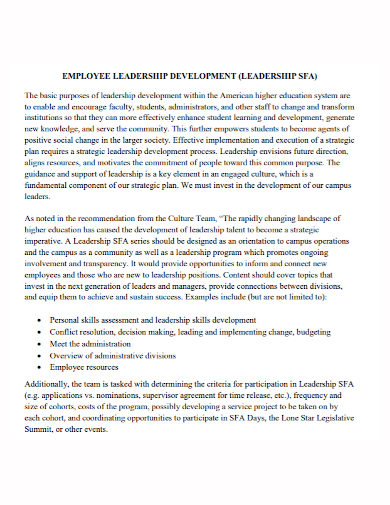Leadership development enhances the capabilities of individuals so that they can assume leadership roles and responsibilities in the workplace. This includes programs in management, executive education, seminars, workshops, and even internships. The opportunities given by leadership development can range from developing basic knowledge, skills, self-awareness, and the abilities that are needed in order to lead effectively. Having a strong leadership base in the business and corporate industry can ultimately determine the success of your organization. If the company that you are working in is committed to developing its leaders, then you can expect a significant increase in the competitive advantage in the industry. Especially leaders that are to operate in managerial positions. Attracting, developing and retaining talent, driving strategy execution, and increasing your chances of success, especially when you are trying to promote leadership within your employees.
Though despite the importance of proper leadership training and development within the business, a lot of organizations still fall short on it. More often than not, individuals who are assigned to leadership roles typically don’t have a lot of training and experience that they need. The lack of proper leadership in an organization can be very detrimental. It can, for example, result in massive loss in productivity, high turnover rates, low morale, absenteeism, and a whole lot more.
It is massively important for businesses and companies worldwide to be able to come up with their own leadership development plan to be established within their organization. The document can be incredibly useful in making sure that your company has a strong set of leaders now and in the future. The growth and evolution of your company leaders can have a direct and lasting impact to how your company grows and evolves. Creating a leadership development plan outlines the details of the steps that you need to identify and nurture the next generation of leaders of your organization. Taking care of employees is always a must for every organization. And the employees themselves have a legal right to be taken care of at work. So naturally, you will need a leader that knows what and how to prioritize the needs of their employees to make sure that they are as productive yet as healthy as they can be.
Leadership is always important everywhere. Especially in workforces that consists a huge population of people, or just those who work with any people in general. So you have to keep in mind that writing a leadership development plan may not be the easiest thing to do in the world. That is why before you attempt to draft the document yourself, first check out these employee leadership development plan samples that we have listed for you down below. After you’ve gotten yourself familiar with the document, you can then use these samples as guides or templates for when you actually begin to write an employee leadership development plan.
5+ Employee Leadership Development Plan Samples
1. Employee Leadership Development Plan Template

2. Employee Leadership Development Action Plan
3. Employee Engagement Leadership Development Plan
4. Employee Leadership Development Implementation Plan
5. Employee Professional Leadership Development Plan
6. Sample Employee Leadership Development Plan
What Is an Employee Leadership Development Plan?
A leadership development plan is a document that is designed to assist employees and potential employee leaders gain and develop their own leadership competencies to prepare them for managerial and leadership roles in your company. A leadership development plan outlines the different steps that you need so that your appointed employees become a better leader. It should cover the list of the skills that you need in order to improve, the responsibilities that you have to take on, and the tasks that you need to complete. Most leadership development plans are used as agreements between an employer and an employee. For employee leadership development plans, the benefits are both for a single individual and the well being of the entire organization.
When leadership development is linked with the business strategy of an organization, the company will be able to associate their own investments in internal training programs and even reimbursements in tuition to expand their goals and strategic plans. Efforts like these can lead to an even bigger likelihood that your management and stakeholders in your company will approve the further development of your plan. Overall, a leadership development plan is a critical document for businesses who wish to continue operating even in times of crises or when working in highly competitive environments. A well developed leadership plan will be able to help you keep your most valuable individuals in your organization, to keep them engaged and keep them from pursuing alternative opportunities from other competing companies. The stronger your leaders are, the better potential your company will have to be able to differentiate itself and remain relevant in a constantly evolving market.
Elements of an Employee Leadership Development Plan
After you have identified the long term leadership goals of your business, as well as the qualities of a leader that you are looking for, you should now be set to draft a leadership development plan of your own. When writing the plan, you need to remember that the components of the document may vary from different employees, as well as different companies. Some organizations may choose to use a spreadsheet, while other may prefer charts. Regardless of how the document is written, there are still basic elements that your leadership development plan should work with. These elements are gonna be listed and discussed in more detail down below.
1. Core skills to master
Leaders may be subject to a number of job responsibilities that are specific to the role that was appointed to them. It can include running meetings, providing feedback, sharing information in front of an audience, and overall decision making. The first things that you need to identify when writing a leadership development plan are the skills that you need that are aligned to your own leadership development goals. You might know people within your company who currently has these skills, so you can try to ask them if they are willing to coach their other members. If not, then you can look for other external resources to help you build these skills.
2. Experience gaps to close
In addition to technical and tactical skills, there are also a couple of strategic responsibilities that a leader might take on. This includes starting on a new project, working on ventures that might not be going well, managing large scale projects, and operating businesses in a crisis.
3. New relationships to build
A potential leader must know how to interact with different stakeholders on a near regular basis. Others may be within your organization alone like department heads, front-line employees, as well as managers with varying degrees of skill. While others may operate outside your own organization ranging from clients to suppliers and board members from other businesses. When writing a leadership development plan, you have to be able to identify the target entities that you wish to work with.
4. Specific tasks to delegate
Effective leaders should know how to balance their energy between day-to-day tasks and long-term commitments or responsibilities. They should know when and where to focus on with tasks that are aligned with their own skillset, and to trust the rest of their team to work on other stuff to make sure that every project is making progress. Make a list of the activities that you need to work with that is aligned with your skills and your role, and another list for the activities that can easily be completed by the rest of your team.
5. Key action items to complete
The specifics of a leadership development plan should also include a comprehensive list of the strengths and the potential areas for improvement. For each area that you plan to work on, include action items and the time frame in which those tasks are to be completed and the resources that are to be consumed by the project. Action items can range from meetings with your mentors, reading books and other resources in leadership, completing a leadership assessment, or identifying training and other educational opportunities.
6. Critical indicators of success
Leaders are evaluated not only by how successful they are, but also by how successful the team is that they are leading. A list of indicators of success should be included within your leadership development plan, designed to assess the progress of both the leader and the team. Your indicators of success can include the following.
- Improving the quality of work
- Improving teamwork and morale
- Increasing delegation of responsibility
- Strategic planning and preparation
- Continuous learning for you and your team
- Recognizing the contributions of the team
FAQs
What are the five SMART objectives?
- Specific
- Measurable
- Achievable
- Realistic
- Timed
What are the five components of a leadership development plan?
- Coaching
- Accountability
- Change Management
- Influence and Negotiation
- Communication
What are the 7 leadership skills?
- Willingness to listen
- Perseverance
- Honesty
- Selflessness
- Decisiveness
- Trust
- Integrity
Leadership development plans work best as a live document. It should be something that you inspect and update on a regular basis to make sure that you are properly addressing the areas of improvement that you have identified for your new set of leaders.
Related Posts
FREE 9+ 30-Day Marketing Plan Samples in PDF | MS Word | Apple Pages | Google Docs
FREE 3+ Sales Team Action Plan Samples in PDF | MS Word | Apple Pages | Google Docs
Marketing Plan For Small Business Samples
FREE 7+ Fashion Business Plan Samples in PDF
FREE 10+ Sprint Planning Samples In MS Word | Google Docs | PDF
FREE 10+ Wedding Planning Samples in MS Word | Apple Pages | Powerpoint | PDF
FREE 9+ Monthly Study Planner Samples in PSD | Illustrator | InDesign | PDF
FREE 9+ Sample Curriculum Planning Templates in PDF | MS Word
FREE 10+ Teacher Development Plan Samples in MS Word | Google Docs | Apple Pages | PDF
FREE 10+ Basketball Practice Plan Samples in PDF
FREE 12+ School Business Plan Samples in PDF | MS Word | Apple Pages | Google Docs
FREE 7+ Client Strategic Plan Samples in PDF | MS Word
FREE 11+ Trucking Business Plan Templates in PDF | MS Word | Google Docs | Pages
FREE 7+ Small Hotel Business Plan Samples PDF | MS Word | Apple Pages | Google Docs
FREE 14+ Bakery Business Plans in MS Word | PDF | Google Docs | Pages





